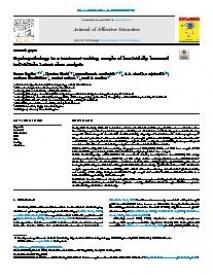Psychopathology in a treatment-seeking sample of homicidally bereaved individuals : Latent class analysis
Background
Violently bereaved individuals are at increased risk of developing severe and comorbid disorders. Comorbidity may increase psychiatric symptom severity and suicide risk and decrease psychosocial functioning compared with having one disorder. We aimed to identify subgroups of individuals with similar symptom patterns, describe prevalence rates and overall levels of prolonged grief disorder (PGD), posttraumatic stress disorder (PTSD), major depressive disorder (MDD), and generalized anxiety disorder (GAD) per class, and explore associations between class membership and personal and homicide related variables.
Methods
We investigated the comorbidity of symptoms of PGD, PTSD, MDD, and GAD in a sample of 923 treatment-seeking homicidally bereaved individuals by deploying latent class analysis.
Results
Three subgroups were identified: (i) a moderate distress, low depression class (12.4%), (ii) a high distress, moderate depression class (42.7%), and (iii) a high distress and high depression class (45.0%). Prevalence rates and total scores of the questionnaires followed the pattern of iii ≥ ii ≥ i (ps ≤ .001). Being female and having experienced prior life stress distinguished between all classes (ps ≤ .05). Limitations: The data-driven analytic approach and reliance on self-reported routine outcome monitoring data limit the generalizability and validity of the study. Strengths include the large sample size and the inclusion of four measures in a treatment-seeking, violently bereaved sample.
Conclusions
Classes were most clearly distinguishable based on symptom severity, indicating high comorbidity following bereavement by homicide. This argues for an integrated treatment that targets different complaints simultaneously rather than successively.
Highlights
• Over 80% of homicidally bereaved patients reported comorbid symptomatology.
• The three classes were distinguishable by symptom severity patterns.
• ‘Female gender’ and ‘prior life stress’ distinguished between all classes.
• Integrative treatment is needed to target comorbidity after homicidal bereavement.
In: Journal of Affective Disorders ; ISSN : 0165-0327 | 292 | september | 234-241
https://doi.org/10.1016/j.jad.2021.05.026
Open access


